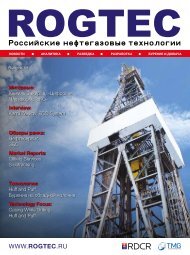ROGTEC Issue 62
Russian Oil & Gas Magazine
Russian Oil & Gas Magazine
You also want an ePaper? Increase the reach of your titles
YUMPU automatically turns print PDFs into web optimized ePapers that Google loves.
ГЛОБАЛЬНАЯ ЭНЕРГЕТИКА
акцент с разведки и добычи ископаемого топлива
на общее производство энергии. Диверсификация
форм источников энергии является императивом
для выживания отрасли в современный кризис.
Следуя этим курсом, отрасль в настоящее время
входит в эпоху, определяемую интенсивной
конкуренцией, скорыми технологическими
инновациями, отвечающими на всевозможные
запросы клиентов, вялым или падающим спросом
на продукцию, инвестиционным пессимизмом,
и усиливающимся давлением общества и
политиков, в связи с изменением климата, и
актуальностью вопросов защиты окружающей
среды.
3. Цифровая революция уводит
специалистов в сферу возобновляемой
энергетики
Нефтегазовая отрасль переживает свой третий, за
последние 12 лет, коллапс цен. После первых двух
потрясений отрасль вернула позиции, и бизнес
продолжил свою обычную активность. На этот
раз, все по-другому. Текущая ситуация объединяет
потрясения в мировой системе логистики и
беспрецедентное падение спроса в силу глобальной
угрозы человечеству.
Перед лицом существующего геополитического,
социологического и экономического климата,
нефть и газ становятся все более рискованными
активами для компаний венчурного капитала,
готовящихся к очередному большому
экономическому спаду. Стремление избежать
лишних рисков отражается на организационной
культуре, когда компании смотрят на
возможность более экономного подхода к
операциям, с применением автоматизации и
цифровизации. Такие инициативы повышают
эффективность и существенно сокращают
производственные расходы. В дополнение
к экономии затрат, цифровизация также
увеличивает производительность посредством
увеличения времени работы оборудования,
оптимизации стратегий разработки
месторождений, и сокращения выбросов в
атмосферу парниковых газов. Цифровизация,
с другой стороны, оказывает влияние на
значительное количество специалистов,
«вымываемых» из отрасли. Только за последнее
десятилетие нефтегазовый сектор навсегда
покинуло около 500 000 профессионалов, среди
которых 40-50% квалифицированной рабочей
силы, которым до пенсии оставалось от 6 до 10
лет. То, что отрасль отреагировала на пандемию
COVID-19 замораживанием процесса найма
energy sources developed within the EU itself. Solar
and wind energy are free goods that are essentially
available everywhere. The more power generated from
renewable sources in the EU, the less it has to rely
on importing energy from abroad, worry about the
inefficient supply chains or price volatility of fossil fuels.
This is fully aligned with the EU’s net zero-emission and
minimal environmental impact strategy that is planned
to be obtained by 2050. EU has had an appetite to
move towards being energy self-sufficient for quite
a while now and COVID-19 will only speed up this
process. Relatively lower energy consumption rates
caused by the pandemic are the perfect opportunity to
perform this shift.
In the EU in 2018, the dependency rate was equal
to 58%, which means that more than half of the EU’s
energy needs were met by net imports (figure 5). The
dependency rate on energy imports has increased since
2000 when it was just 56%. Energy supply chains are
critical for the European economy and the countries
cannot survive currently without external sources of
energy.
As the cost of renewables reduces, many European
countries will reach a tipping point in the coming five
years (2020 – 2025), where newbuild solar or wind
capacity will be cost-competitive with the fuel cost
of existing conventional plants. As a result, a further
acceleration of the ramp-up of renewables will occur.
Countries that are similarly heavily reliant on fossil
fuel imports will have to significantly improve their
trade balance and reduce the risks associated with
vulnerable energy supply lines and volatile fuel prices by
developing a greater share of energy domestically.
5. The East is also Green
China has also taken the lead in the clean energy race
to become the world’s largest producer, exporter, and
installer of solar panels, wind turbines, batteries, and
electric vehicles. In case of fossil fuel energy sources,
apart from national coal resources, the country
would heavily depend on external supplies. China’s
commitment to invest in renewables is due to its
large potential for further production and increase
in consumption. By 2030, one-fifth of the country’s
electricity consumption is forecast to come from
non-fossil fuel sources. According to the International
Energy Agency, 36% and 40% of the world’s growth
in solar and wind energy in the next five years will
come from China. Renewable energy deployment
is also a part of a larger China’s effort to develop a
cross-industrial approach to lower pollution levels
and the coal usage, mitigate climate change, and
improve energy efficiency.
56
ROGTEC
www.rogtecmagazine.com















